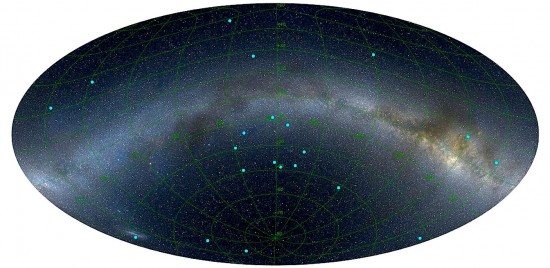
GRBs at a reported distance of 7 billion light years (blue dots), with the Milky Way as a reference. Credit: L. Balazs
Aug 7, 2015
Sometimes, one theory depends on another one to survive.
According to a recent press release, the largest observable structure in the Universe was identified by a team of astronomers from Hungary and the United States. The vast ring of galaxies, over five billion light years in diameter, was discovered because the light from several gamma-ray bursts (GRB) displayed a circular arrangement. Since modern astronomical theories associate gamma-ray bursts with active galactic nuclei, astronomers infer the galactic ring because of the GRB observations.
Professor Lajos Balazs said: “If we are right, this structure contradicts the current models of the universe. It was a huge surprise to find something this big – and we still don’t quite understand how it came to exist at all.”
One possibility, not considered by today’s astronomers, is their difficulty in adapting new observations to existing theories is because those theories do not include electricity as a factor. Instead, redshift is the commonly accepted way that objects in space are “placed” at their proper distances. Using parallax measurements, the distance to nearby stars can be determined. However, beyond a few light-years, angles are so small that they cannot be resolved. Therefore, redshift came into play so that the distance to more remote bodies could be determined.
By way of review, Edwin Hubble, using the 100-inch telescope at Mt. Wilson observatory, believed that he had observed galaxies receding from the Milky Way. The most surprising piece of his recorded data was not the recession itself, but the high velocities associated with his measurements. According to his calculations, some galaxies were traveling away from his observatory at thousands of kilometers per second.
Adapting the Doppler effect (named for the Austrian physicist Christian Doppler, who came up with the idea in 1842) to the spectra of various galaxies, Hubble thought that the change in location of particular elemental signatures called Fraunhofer lines (for the German physicist Joseph von Fraunhofer) indicated that the lightwaves had been shifted toward the red end of the spectrum by an apparent recessional velocity.
Fraunhofer lines are supposed to occur at specific frequencies identified in the spectrum by the kind of element that is absorbing the light. If they are in a different location, they have been Doppler-shifted because of the element’s acceleration. This forms the backbone of galactic-scale distance calculations and the supposed speed of recession that galaxies display. The problems with redshift are not the topic of this paper. Suffice to say, Doppler’s ideas are improperly attributed to stellar distance. Redshift is one of the main theories behind placement of GRBs at such colossal distances.
Consensus opinion among astrophysicists is that there are supermassive black holes (SMBH) in the centers of the galaxies in which GRBs are detected. Material from surrounding star systems is said to be pulled into the SMBHs, where it is accelerated by intense gravity fields. The extreme gravity supposedly heats up particles as they approach the speed of light. It is that excitation that is said to create X-rays and gamma-rays. That is the second theory that forms that basis for GBRs, relying on black hole physics for their very existence. Again, the problems inherent with black hole theory are discussed elsewhere and are not included in this paper.
The signature of a dense plasma focus is helical strands of energy surrounding a powerfully radiating arc-mode discharge with a dark-current torus. The electric filaments are helical magnetic fields that confine plasma. The dense plasma focus device, or “plasma gun” provides a mechanism by which cosmic electric currents can influence the evolution and morphology of space structures. This theory is based on a proposal by Hannes Alfvén for the formation of structures in space that does not depend on gravity alone. In 1960 he wrote:
“The earth, the sun and many stars possess general magnetic fields. It is possible that interstellar clouds are magnetized, that spiral arms have regular magnetic fields, and that galaxies also have general magnetic fields. Even if the views of different authors are still conflicting, it seems reasonably certain that interstellar matter is usually magnetized. This makes it likely that there should be some very general process which produces magnetic fields in fluid bodies as different as the earth’s fluid interior, the stars, and interstellar matter. The energy required for magnetization can easily be drawn from the kinetic energy of internal motions, but the difficulty is to find a workable mechanism from the production of magnetic fields.” (Alfvén, H. “On the Origin of Cosmic Magnetic Fields”, Royal Institute of Stockholm, October 28, 1960).
An electromagnetic z-pinch can squeeze plasma so that it rapidly compresses. Electric charge flowing into the z-pinch might force the plasma to erupt in an arc-mode discharge. Planetary nebulae are plasma, as well as the “remnants” of supernovae, the active centers of galaxies, and the stars, themselves. They behave according to the laws of electric discharges and circuits. No black holes are necessary when electric discharges are brought into play. GRB’s are not so far away, they are nearby phenomena that are mistaken for something happening at a distance. In this case, two conventional theories combined to form a ring in space that should not exist because it does not exist.
Stephen Smith












